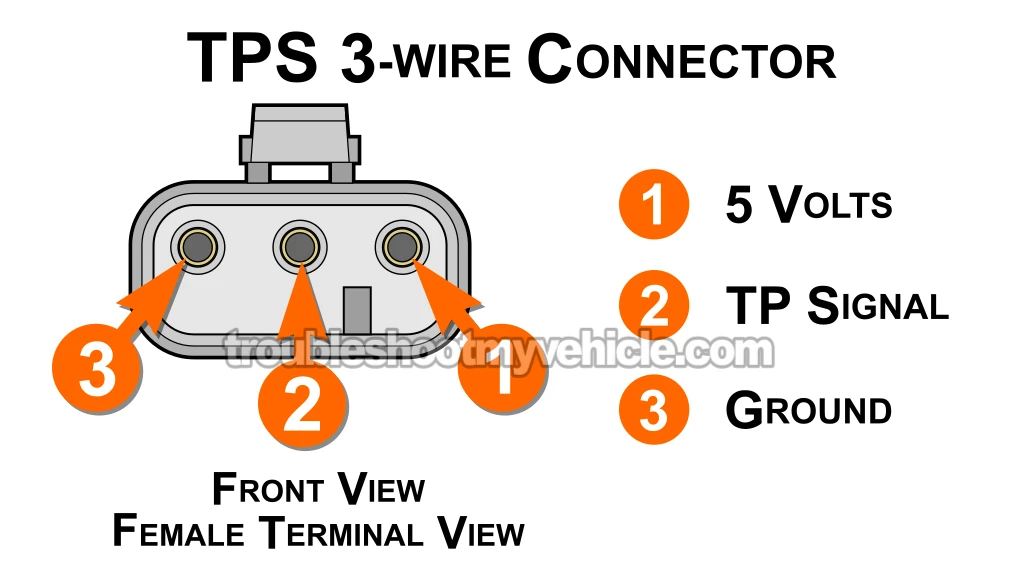
To test your throttle position sensor (TPS), all you need is a multimeter (no scan tool is required). In this tutorial, I'll show you how to test it in a step-by-step manner.
You'll be able to easily and quickly determine whether the TP sensor is functioning correctly with three simple tests.
Contents of this tutorial at a glance:
APPLIES TO: This tutorial applies to the following vehicles:
- 3.9L V6 Dodge Ram B150 Van: 1991.
- 3.9L V6 Dodge Ram B250 Van: 1991.
Symptoms Of A Bad Throttle Position Sensor
As you're aware, the accelerator pedal connects to the throttle plate via a mechanical cable. When the engine is running, this is what happens:
- When you press the accelerator pedal, the throttle plate opens, allowing more air to enter the engine.
- When you release the pedal, the throttle plate closes, reducing airflow into the engine.
Your Dodge Ram van's fuel injection computer keeps track of the throttle plate angle (as you press or release the accelerator pedal) with the throttle position sensor.
When the TP sensor malfunctions, engine performance goes out the window. Below are some symptoms you may encounter:
- Trouble codes: The following trouble codes will illuminate the check engine light (CEL):
- Code 24: TPS Voltage Is Too Low.
- Code 24: TPS Voltage Is Too High.
- Engine no-start: The engine won't start no matter how long you crank it.
- Hard start: You may need to crank the engine several times before it starts.
- Engine hesitation: Hesitation during acceleration from a stop or while driving.
- Lack of power: You'll notice a lack of power, whenever you step on the gas pedal.
- Bad gas mileage: The fuel injection system will switch to 'limp-in' mode, which reduces engine output to prevent damage but wreaks havoc on gas mileage.
Where To Buy The TPS And Save
The following links will help you to comparison shop for the TPS for your 3.9L V6 Dodge Ram van. I think they'll save you a few bucks:
If you're unsure if this TPS is compatible with your specific 3.9L V6 Dodge Ram van, no worries. Once you visit the site, they'll check and ensure it's the right one by asking for more details about your vehicle. If it doesn't fit, they'll help find the correct one.
TEST 1: Testing The TPS Voltage Signal

As I previously mentioned, the throttle position sensor generates a voltage signal based on the position of the throttle plate.
Here's how a properly working TPS behaves:
- Closed throttle: The TPS outputs a low voltage when the throttle plate is fully closed.
- Throttle opening: As the throttle plate begins to open, the TPS sends a gradually increasing voltage signal.
- Wide Open Throttle (WOT): At full throttle, the TPS typically produces around 4.5 Volts DC.
- Throttle closing: As the throttle plate returns to the closed position, the voltage decreases accordingly and settles back to its original low value.
Generally, if the TPS fails, its voltage signal will not increase or decrease as the throttle plate opens or closes.
NOTE: You'll need a multimeter to be able to test the throttle position sensor. If you don't have one, this is the one I use and recommend: Tekpower TP8268 AC/DC Auto/Manual Range Digital Multimeter (at: amazon.com).
IMPORTANT: The TP sensor must remain connected to its electrical connector. You'll need to use a back probe on the connector or wiring piercing probe to access the signal in the wire. You can see an example of this tool here and where to buy it: Wire Piercing Probe.Let's get started:
- 1
Connect the black multimeter test lead to the negative (-) battery terminal.
- 2
Set your multimeter to Volts DC mode.
- 3
Turn the key to the ON position but don't start the engine.
- 4
Connect the red multimeter test lead to the middle wire of the connector using a suitable tool (back probe or wire-piercing probe).
NOTE: The TP sensor must remain connected to its electrical connector. - 5
Your multimeter should display a voltage reading between 0.2 to 0.9 Volts DC at this point (with the throttle plate closed).
If your multimeter doesn't show this, don't worry. Continue to the next steps. - 6
Slowly open the throttle by hand from the engine compartment.
- 7
The voltage should increase.
When the throttle plate is fully open, your multimeter should read between 3.5 to 4.5 Volts DC. - 8
Slowly close the throttle plate.
- 9
The voltage should decrease back to its closed throttle value.
- 10
Gently tap the throttle position sensor with a screwdriver handle while you open and close the throttle plate.
If the TPS is faulty, tapping will cause the voltage signal to glitch. On a good TPS, tapping it will not have any effect on its voltage signal output.
Let's examine your test results:
CASE 1: The TPS signal voltage increased/decreased as you opened/closed the throttle plate. This is the correct test result and confirms that the throttle position sensor is functioning properly.
Additionally, this result confirms that the TPS is receiving both power and Ground from the fuel injection system.
CASE 2: The TPS signal voltage STAYED STUCK in one value as you opened/closed the throttle plate. This test result typically indicates that the TPS is faulty.
To confirm whether the TPS is indeed bad, you need to make sure it's receiving both power and Ground. Go to: TEST 2: Making Sure The TPS Is Receiving 5 Volts.
CASE 3: The multimeter DID NOT register any voltage during the test. This result usually suggests the TP sensor is bad.
Before you run out and replace it, you need to make sure it's getting power and Ground. Go to: TEST 2: Making Sure The TPS Is Receiving 5 Volts.



